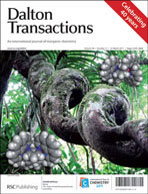The Pt(II) coordination chemistry of oligocationic ammoniomethyl- and neutral aminomethyl-substituted triarylphosphines (L) is described. Complexes of the type PtX2(L)2 (X = Cl, I) have been isolated and characterized. For the hexa-meta-ammoniomethyl-substituted ligands [1]6+ and [2]6+, two ligands always occupy a trans-configuration with respect to each other in complexes of the type PtX2(L)2, while for the tri-para-ammoniomethyl-substituted ligand [7]3+, the trans/cis ratio is dependent on the ionic strength of the solution. This behaviour was not observed for the neutral aminomethyl-substituted ligands. In the crystal structure of trans-[PtI2(1)2]I12, the geometrical parameters of the phosphine ligand [1]6+ are very similar to those found in the analogous complex of the benchmark ligand PPh3, i.e. trans-PtI2(PPh3)2, indicating that no significant increase in the steric congestion is present in the complex. Instead, the coordination chemistry of this class of phosphine ligands is dominated by repulsive Coulombic inter-ligand interactions.

You have access to this article
 Please wait while we load your content...
Something went wrong. Try again?
Please wait while we load your content...
Something went wrong. Try again?


 Please wait while we load your content...
Please wait while we load your content...